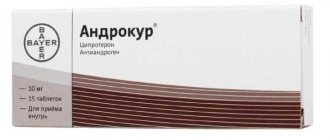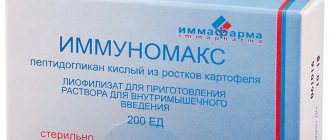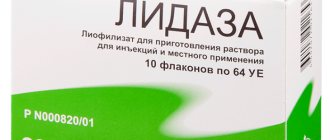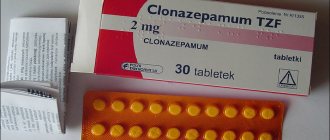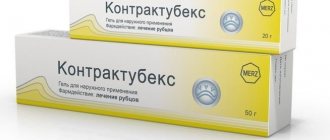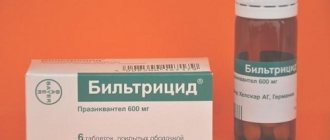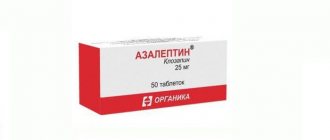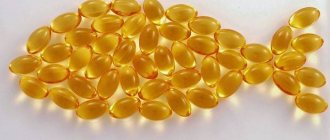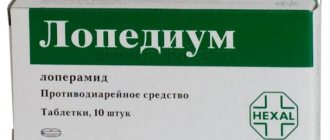5378
Author of the article
Evgeniy Nikolaevich Konoplev
Reading time: 5 minutes
AA
Abactal is an antibacterial agent of the fluoroquinolone group with antimicrobial properties. The drug has a wide range of uses. The drug is used to treat chronic bronchitis, pneumonia, osteomyelitis, and infectious lesions of soft tissues. In medical practice, Abaktal is used to prevent infections in patients with immunodeficiency.
Composition and release form
The medicine contains the active substance pefloxacin mesylate dihydrate, which corresponds to 400 mg of pefloxacin. Additional components depend on the form of release of the drug:
- Pills. Additionally they contain lactose monohydrate, corn starch, sodium carboxymethyl starch, povidone, magnesium stearate, talc, hypromellose, magrocol, carnauba wax, titanium dioxide.
- The powder for the preparation of solution for injection contains disodium edetate, ascorbic acid, sodium bicarbonate, benzyl alcohol, sodium metabisulfite, distilled water.
The drug is produced by the Slovenian company LEK and the Russian company Sotex Pharmfirma.
Analogues of Abaktal
Level 4 ATX code matches:
Siflox
Hyleflox
Leflobakt
Lefoccin
Gatifloxacin
Ofloxacin
Faktiv
Tigeron
Lebel
Zanotsin
Lomefloxacin
Eleflox
Lomflox
Pefloxacin
Tsiprobay
Sparflo
Tariwid
Zoflox
Moxifloxacin
Levofloxacin
Pelox-400, Pefloxacin mesylate, Pefloxacin-AKOS, Peflacin, Unikpef . These analogues of Abaktal have one active ingredient.
Effect of the drug
Abactal is an antibacterial agent of the fluoroquinolone group. Fluoroquinolones are drugs that have a strong bactericidal effect. The effect of fluoroquinolones on pathogenic microorganisms is similar to antibiotics. The difference between the medicinal groups is that antibiotics are of natural origin, while fluoroquinolones are synthetic drugs and have no analogues in nature.
As a result of the action of the active substance pefloxacin, the proliferation of pathogenic microorganisms is suppressed at the genetic level. The pathogenic flora stops synthesizing DNA molecules, as a result, cell replication stops.
Pefloxacin is active against gram-positive and gram-negative bacteria in the process of division. The antimicrobial effect of the drug is due to the fluorine content in its composition.
After administration, the active substance is quickly absorbed and enters the systemic circulation. In this case, the maximum concentration of the drug in the blood plasma is observed after two hours. During a course of treatment, the largest amount of the substance in the body is observed after 48 hours.
Pefloxacin is able to penetrate into the internal fluids of the body: saliva, bronchial secretions, amniotic and synovial fluid, sputum. The substance is concentrated in bone tissue and the prostate gland, where its content can exceed plasma concentrations up to seven times.
The period of elimination of Abaktal from the body is quite long and amounts to 48 hours. This allows you to use the medicine twice a day. Metabolism of the drug occurs in the liver. The main part of the metabolites and drug residues are excreted by the kidneys, a small amount is excreted by the intestines. The half-life is 8 hours, with repeated use of the drug - 12 hours.
The main distinguishing feature of Abaktal is its ability to influence pathogens, both dormant and actively reproducing. Tuberculosis bacteria and spirochetes are resistant to the drug.
Pharmacological properties of the drug Abaktal
The medicine has a wide spectrum of action due to its antibacterial properties.
Pharmacodynamics
The medicine has high activity against Staphylococcus aureus, Salmonella, Shingella, Escherichia coli, pathogens of gonorrhea, Proteus, Pseudomonas aeruginosa. Moderate activity
Abaktala is observed against streptococci, pathogens of bronchitis and tetanus, mycoplasmas, chlamydia. There is absolutely no activity against spirochetes and tuberculosis pathogens.
Pharmacokinetics
- Suction. Pefloxacin (active component) is absorbed from the gastrointestinal tract. The highest concentration of the substance is observed quite quickly after administration - after an hour and a half.
- Distribution. Medicinal substances penetrate the organs, tissues and fluids of the body at high speed. In blood plasma their concentration is much lower.
- Excretion. Half-life is more than 10 hours. Withdrawal time is about 48 hours. 1/2 of the dose taken is excreted in the urine, 30% in bile, and the remainder in the form of metabolites. But these indicators are typical for patients who do not complain about the liver and kidneys.
Indications
The medicine is used to treat a wide range of diseases. The antibiotic Abaktal is indicated if the patient is diagnosed with the following diseases:
- pathologies of the respiratory system: pharyngitis, sinusitis, bronchitis, tonsillitis, cystic fibrosis, pneumonia;
- otitis;
- urethritis, cystitis, pyelonephritis, endometritis, prostatitis;
- chlamydia, gonorrhea;
- salmonellosis, typhoid fever, cholera, paratyphoid fever;
- soft tissue infections;
- infected wound surfaces, burns;
- tubo-ovarian abscess;
- peritonitis, endocarditis, inflammation inside the abdominal cavity;
- bacterial, post-traumatic and post-operative meningitis;
- infectious diseases in persons with immunodeficiency conditions;
- prevention of nosocomial infection.
Indications for use
The use of Abaktal, reviews confirm this, is advisable in the following cases:
- For the treatment of infectious diseases, various parts of the respiratory tract and ENT organs (pneumonia, acute and chronic bronchitis, cystic fibrosis, bronchopulmonary infection, sinusitis, tonsillitis, tonsillitis, etc.);
- In the treatment of sexually transmitted diseases (gonorrhea, chlamydia);
- for the treatment of infectious diseases affecting the gastrointestinal tract and liver (salmonellosis, shigellosis, cholecystitis, cholera, etc.);
- For the treatment of infectious diseases affecting bones and joints (arthritis, osteomyelitis);
- For the treatment of infectious diseases affecting the soft tissues of the body (burns that have become infected, abscesses, ulcers, etc.);
- For the treatment of nosocomial infections (also used as a prophylactic against them);
- As part of therapy for patients who have undergone gynecological and surgical interventions;
- In the treatment of intraperitoneal abscesses, peritonitis;
- In the treatment of bacterial meningitis.
Abaktal is prescribed as a monotherapeutic agent or as part of complex therapy.
Abaktal can also be used by patients with a weakened immune system.
Instructions for use
Abactal in a dosage of 400 mg is used as part of complex treatment and monotherapy. The daily dose of the drug is 800 mg. It is recommended to take the drug twice a day, 400 mg. This will help maintain the required amount of the drug in the blood plasma.
According to the instructions for use, Abaktal tablets are used to treat diseases of the urinary system . The drug is taken one tablet once a day.
Treatment of uncomplicated gonorrhea is carried out by taking two tablets of the drug at a time. For renal failure, the medicine is taken one tablet once every 24 hours. The daily dose should not exceed 1.2 grams of the product. It is recommended to use the medicine during meals, without chewing and with plenty of liquid.
Abactal in ampoules should be used for infusion administration. Drip administration of the drug is carried out strictly in a hospital setting. Before use, a test is carried out to determine the tolerability of the antibiotic. Intravenous infusion is carried out twice a day, 400 mg. To avoid accumulation of pefloxacin in organs and tissues, the infusion is carried out slowly. Typically the procedure lasts one hour.
In order to prevent the development of infection in the postoperative period, the drug is administered parenterally at a dose of 400 mg before surgery. For patients over 65 years of age, the dose of the drug must be adjusted taking into account existing diseases.
The effectiveness of Abaktal is assessed after three days.
Patient reviews
Irina Kuzmina, 34 years old, Pyatigorsk: “During the next exacerbation of chronic bronchitis, the doctor prescribed a complex treatment, which included taking Abaktal in the form of tablets. This is an antibiotic, so I also had to take medications to normalize the microflora. The medicine is not cheap, but it is effective. I took 1 tablet for breakfast and dinner for 5 days. There were no side effects, recovery came quickly.”
Alexey Steblov, 41 years old, Stavropol: “The urologist prescribed me to take 1 tablet 2 times a day. I started treatment with an evening dose. I took a pill and after about an hour I felt unwell: tinnitus, my tongue was almost numb, my legs were cold. I suffered all night, and in the morning I went to the doctor. The doctor prescribed another drug, which I tolerate well. I will no longer be treated with Abactal.”
Contraindications and side effects
Before using the drug, you should read the instructions, since the medicine has a fairly large list of contraindications. Abaktal should not be used for treatment if the patient has the following diseases:
- hypersensitivity to the components included in the drug;
- liver failure;
- lactose intolerance;
- lactase deficiency;
- tendon diseases caused by the use of fluoroquinolone drugs.
The medicine is not used to treat children under 18 years of age, since at an early age the drug can cause arthropathy of large joints.
The use of the drug during pregnancy and lactation is strictly prohibited, since pefloxacin has the ability to penetrate into amniotic fluid and breast milk, which can have a negative impact on the development of the fetus and the health of the child.
It is used with extreme caution to treat patients suffering from epilepsy, convulsive syndrome, cerebrovascular accidents, organic lesions of the central nervous system, heart failure, cardiac arrhythmias, renal and liver failure, and diabetes.
Treatment with Abactal may be accompanied by side effects. Patients may experience pain in muscles, joints and ligaments, and there is a risk of ankle tendon rupture and ligament inflammation.
After taking the drug, patients complain of headaches, dizziness, insomnia, irritability, increased anxiety, and tremors of the limbs . In rare cases, confusion, hallucinations, depression are observed, visual acuity decreases and taste perception changes.
Allergic reactions are accompanied by skin rashes, itching, skin hyperemia, urticaria, and photosensitivity . may occur at the site of antibiotic administration .
Long-term use of Abaktal can cause an overdose, which is characterized by the following symptoms:
- nausea and vomiting;
- headache;
- dizziness;
- disturbance of consciousness;
- convulsive syndrome;
- loss of consciousness.
To treat an overdose, rinse the stomach, induce vomiting and take an adsorbent. Further therapy is carried out in a hospital setting.
Abaktal solution d/in. 400 mg/5 ml. amp. 5 ml. No. 10 16688
Description
Abaktal®
Sandoz CJSC (Russia)
film-coated tablets 400 mg; blister 10, cardboard pack 1; EAN code: 3838957492800; No. P N008768/02, 2010-08-18 from Lek (Slovenia)
Latin name
Abaktal®
Active substance
Pefloxacin*(Pefloxacinum)
ATX:
J01MA03 Pefloxacin
Pharmacological group
Antimicrobial agent, fluoroquinolone [Quinolones/fluoroquinolones]
Nosological classification (ICD-10)
A00 Cholera A01 Typhoid and paratyphoid A01.1 Paratyphoid A A01.2 Paratyphoid B A01.3 Paratyphoid C A02 Other salmonella infections A03 Shigellosis A04.0 Enteropathogenic infection caused by Escherichia coli A28.2 Extraintestinal yersiniosis A39.0 Meningococcal meningitis A54 Gonococcal infection A56 Other chlamydial sexually transmitted diseases D84.9 Immunodeficiency, unspecified G00 Bacterial meningitis, not elsewhere classified G00.9 Bacterial meningitis, unspecified G03.9 Meningitis, unspecified H70 Mastoiditis and related conditions I33.0 Acute and subacute infective endocarditis J01 Acute sinusitis J06 Acute upper respiratory tract infections of multiple and unspecified localization J18 Pneumonia, unspecified pathogen J20 Acute bronchitis J22 Acute lower respiratory tract respiratory infection, unspecified J32 Chronic sinusitis J42 Chronic bronchitis, unspecified J47 Bronchiectasis [bronchiectasis] K65 Peritonitis K65.8 Other types of peritonitis K81 Cholecystitis K83.0 Cholangitis K85 Acute pancreatitis K86.1 Other chronic pancreatitis L08.9 Local infection of the skin and subcutaneous tissue, unspecified L98.9 Lesion of the skin and subcutaneous tissue, unspecified M00.9 Pyogenic arthritis, unspecified (infectious) M79.8 Other specified lesions of soft tissues M86 Osteomyelitis M89. 9 Bone disease, unspecified N10 Acute tubulointerstitial nephritis N11 Chronic tubulointerstitial nephritis N12 Tubulointerstitial nephritis, not specified as acute or chronic N39.0 Urinary tract infection without established localization N41 Inflammatory diseases of the prostate N45 Orchitis and epididymitis N45.9 Orchitis, epididymitis and epididymo-orchitis without mention of abscess N49 Inflammatory diseases of the male genital organs, not elsewhere classified N70 Salpingitis and oophoritis N71 Inflammatory diseases of the uterus, other than the cervix N73.5 Pelvic peritonitis in women, unspecified N74.3 Gonococcal inflammatory diseases of the female pelvic organs (A54.2+ ) N75 Diseases of Bartholin's gland O85 Puerperal sepsis Z100* CLASS XXII Surgical practice Z98.8 Other specified post-surgical conditions
Description of the dosage form
White to slightly yellowish oval, biconvex, film-coated tablets.
pharmachologic effect
Pharmacological action: broad-spectrum antimicrobial, bactericidal.
Pharmacodynamics
Pefloxacin is a synthetic antimicrobial drug from the group of fluoroquinolones. Acts bactericidal, inhibiting the enzyme DNA gyrase and bacterial DNA replication; also disrupts the replication of the A-subunit of ribonucleic acid and the synthesis of proteins by the bacterial cell. In relation to gram-negative bacteria, it acts on cells that are both in the resting phase and in the division phase; in relation to gram-positive bacteria - only on cells that are in the process of mitotic division. A post-antibiotic effect is characteristic. Pefloxacin has a broad spectrum of antimicrobial action.
Active against gram-positive bacteria: Staphylococcus aureus, Staphylococcus epidermidis, Staphylococcus saprophyticus.
Moderately sensitive: Streptococcus spp., including Streptococcus pneumoniae, Enterococcus spp.
Shows activity against a number of gram-negative cocci and bacteria, of which are moderately sensitive: Acinetobacter spp., Gardnerella vaginalis, Mycoplasma spp., Clostridium perfringens; sensitive: Escherichia coli, Klebsiella spp., Enterobacter spp., Serratia spp., Proteus mirabilis, Proteus vulgaris, Citrobacter spp., Salmonella spp., Shigella spp., Haemophilus ducreyi, Haemophilus influenzae, Neisseria gonorrhoeae, Neisseria meningitidis, Aeromonas spp. , Campylobacter spp., Moraxella spp., Morganella spp., Pasteurella multocida, Providencia spp., Pseudomonas aeruginosa, Vibrio spp., Yersinia spp., obligate intracellular parasites Chlamydia spp., Chlamydophila pneumoniae, Legionella spp., Ureaplasma urealyticum.
It is not destroyed by beta-lactamases and acts on many strains resistant to penicillins, cephalosporins and aminoglycosides.
The following are resistant to pefloxacin: Staphylococcus spp., methicillin-resistant, Listeria spp., gram-negative anaerobic bacteria (Bacteroides fragilis, Bacteroides spp., Prevotella spp., Fusobacterium spp.), Clostridium spp., Treponema spp., Mycobacterium tuberculosis.
Pharmacokinetics
Absorption is high: within 20 minutes after oral administration, 90% of pefloxacin is absorbed into the gastrointestinal tract. After a single oral dose of 200 or 400 mg of pefloxacin per day to healthy volunteers for 1–1.5 hours, Cmax in blood plasma was 2.5 and 4.3 μg/ml, respectively.
With repeated oral administration of 400 mg of pefloxacin 2 times a day, Cmax and the residual concentration of pefloxacin in the serum were determined within 48 hours: Cmax in the serum was 7.9–10 μg/ml, the residual concentration of pefloxacin in the serum before taking the next dose was 3.8 µg/ml.
After intravenous administration, the pharmacokinetic parameters are the same as after oral administration. The AUC for both routes of administration is the same, indicating complete absorption of pefloxacin. The degree of binding to plasma proteins is 20–30%, Vd is 1.7 l/kg, which ensures uniform distribution throughout organs and tissues. Due to its high Vd, it quickly penetrates and is well distributed in tissues, organs and body fluids, such as saliva, sputum, aortic valve, mitral valve, myocardium, bone tissue, mucous membrane and intestinal wall, peritoneal fluid, pancreatic juice and pancreatic tissue ( including necrotic), gallbladder wall, bile, prostate gland, seminal fluid. Therapeutically significant concentrations in the listed fluids and tissues are higher than concentrations in blood serum.
AUC is 29.5 mg/ml/hour.
Pefloxacin is metabolized in the liver. Pefloxacin metabolism occurs in the liver with the formation of 5 metabolites, 4 of which can be detected in the urine. Part of the administered dose of pefloxacin is metabolized to form the following metabolites: N-dimethylpefloxacin (has significant antibacterial activity), pefloxacin N-oxide and pefloxacin glucuronide.
T1/2 of the drug after a single dose is 10.5 hours, and with repeated oral administration it increases to 12.3 hours.
With both oral and intravenous administration, some accumulation of pefloxacin is observed. Pefloxacin, together with its metabolites, is excreted by the kidneys: with normal renal function - 31–59%. The drug is reabsorbed in the renal tubules.
20–30% of pefloxacin and its metabolites are excreted in the bile. Within 12 hours after oral administration of 400 mg of pefloxacin, its concentration in bile reached 83 μg/ml.
If renal function is impaired, the plasma concentration of pefloxacin and T1/2 do not change.
If liver function is impaired, the plasma clearance of pefloxacin is significantly reduced, and T1/2 increases accordingly.
Indications of the drug Abactal®
The drug Abaktal® is used in the antibacterial therapy of the following diseases caused by microorganisms sensitive to pefloxacin:
central nervous system infections (bacterial meningitis caused by meningococci or gram-negative bacteria, including postoperative or post-traumatic);
infections of the upper respiratory tract and ENT organs (acute and chronic sinusitis, mastoiditis);
lower respiratory tract infections (acute and exacerbation of chronic bronchitis, bronchiectasis, community-acquired and hospital-acquired pneumonia caused by gram-negative bacteria or intracellular pathogens);
abdominal infections (cholecystitis, cholangitis, treatment and prevention of infectious complications of pancreatitis, local and widespread peritonitis, including postoperative);
complicated and uncomplicated infections of the kidneys and urinary tract (acute and exacerbation of chronic pyelonephritis, infectious complications after surgery on the urinary tract);
infections of the pelvic organs in women (pelvioperitonitis, salpingoophoritis, tubo-ovarian abscess, endometritis, bartholinitis);
infections of the reproductive system in men (orchitis, orchiepididymitis, prostatitis);
skin and soft tissue infections caused by penicillin-resistant strains of staphylococcus;
infections of bones and joints (including osteomyelitis caused by gram-negative microorganisms);
bacterial endocarditis;
sexually transmitted infections (gonorrhea, urogenital chlamydia);
bacterial infections of the gastrointestinal tract, incl. Escherichiosis, shigellosis, cholera, salmonellosis, typhoid fever, paratyphoid A, B, C, yersiniosis.
Prevention of infections in patients with immunodeficiency.
Contraindications
hypersensitivity to fluoroquinolones;
patients with glucose-6-phosphate dehydrogenase deficiency (hemolytic anemia);
lactase deficiency, lactose intolerance, glucose-galactose malabsorption syndrome;
children under 18 years of age;
pregnancy and lactation period.
With caution: neurological disorders (epilepsy, convulsive syndrome of unknown etiology, severe organic damage to the central nervous system, cerebrovascular accidents); severe forms of renal and/or liver failure, old age, congenital long QT interval syndrome, heart disease (heart failure, myocardial infarction, bradycardia), electrolyte imbalance (for example, hypokalemia, hypomagnesemia), simultaneous use of drugs that prolong the QT interval (including including class IA and III antiarrhythmics, tricyclic and tetracyclic antidepressants, neuroleptics, macrolides, antifungals, imidazole derivatives, some antihistamines), patients with a history of tendon disease associated with taking quinolones.
Use during pregnancy and breastfeeding
During pregnancy and breastfeeding, the use of Abactal® is contraindicated.
Side effects
From the nervous system and sensory organs: depression, headache, dizziness, increased fatigue, insomnia, increased convulsive readiness, anxiety, increased irritability, agitation, nightmares, visual disturbances, confusion, hallucinations, tremors, convulsions (including including epileptic seizures).
From the digestive system: nausea, vomiting, diarrhea, abdominal pain, changes in taste, loss of appetite, flatulence, pseudomembranous colitis, transient increase in the activity of liver transaminases, as well as alkaline phosphatase and bilirubin concentrations, cholestatic jaundice, hepatitis, liver necrosis.
From the genitourinary system: crystalluria, glomerulonephritis, dysuria, interstitial nephritis.
Allergic reactions: skin rash, skin itching, urticaria, skin hyperemia, photosensitivity (both to sunlight and UV radiation), photoonycholysis, Quincke's edema, bronchospasm.
From the blood system and hematopoietic organs: leukopenia, neutropenia, thrombocytopenia (when used in high doses), agranulocytosis, eosinophilia.
From the musculoskeletal system: myalgia and/or arthralgia, arthropathy, tendonitis, Achilles tendon rupture.
Other: tachycardia, candidiasis, prolongation of the QT interval.
Interaction
Antibiotics: combinations of pefloxacin with aminoglycosides have a synergistic effect against gram-negative aerobic bacteria, incl. Pseudomonas aeruginosa, which allows you to reduce the dose of aminoglycosides and reduce the likelihood of their oto- and nephrotoxicity. Synergistic and additive effects are achieved when pefloxacin is combined with beta-lactam antibiotics, fosfomycin and rifampicin (it should be remembered that rifampicin significantly increases the plasma clearance of pefloxacin, therefore, when using these drugs together, plasma concentrations of pefloxacin in the blood serum should be monitored).
Pefloxacin reduces the metabolism of theophylline, caffeine, and NSAIDs in the liver, which leads to an increase in their concentration in the blood plasma and the central nervous system (to avoid the development of intoxication, the dose of theophylline, caffeine, and NSAIDs must be reduced).
Significantly reduces the prothrombin index (in patients taking oral (indirect) anticoagulants, constant monitoring of blood clotting is necessary).
Cimetidine and other inhibitors of microsomal liver enzymes increase T1/2 of pefloxacin, reduce total clearance, but do not affect Vd and renal clearance.
Antacids (containing aluminum, calcium or magnesium) and preparations containing iron and zinc slow down the absorption of pefloxacin. In this regard, pefloxacin and these drugs must be taken at least 2 hours apart.
When fluoroquinolones and cyclosporine are co-administered, the concentration of creatinine and cyclosporine in the blood plasma may increase.
Pefloxacin can be used in combination with metronidazole and vancomycin.
When used together with tetracycline and chloramphenicol, antagonism is observed.
When pefloxacin is used together with corticosteroids (especially in patients over 60 years of age, in patients with impaired renal function and in patients with dyslipidemia), the risk of adverse events (tendinitis and, in very rare cases, damage to the Achilles tendon) increases.
Due to a decrease in the activity of microsomal oxidation processes in hepatocytes, it increases the concentration and lengthens T1/2 of oral hypoglycemic agents.
Overdose
Symptoms: nausea, vomiting, confusion, psychomotor agitation, in severe cases - loss of consciousness, convulsions.
Treatment: the patient should be under medical supervision. It is necessary to ensure sufficient fluid intake into the body. Treatment is symptomatic, which, if necessary, can be supplemented with hemodialysis and peritoneal dialysis.
special instructions
Abaktal® is used as monotherapy or in combination therapy with other antimicrobial agents.
For mixed infections, for perforative processes in the abdominal cavity, for infections of the pelvic organs, the drug Abaktal® is combined with drugs active against anaerobes (metronidazole, clindamycin).
During treatment, patients should receive plenty of fluids (to prevent crystalluria).
Due to the possible occurrence of a photosensitivity reaction, during treatment with Abaktal® you should not be exposed to UV radiation or prolonged exposure to direct sunlight. If any changes appear on the skin, treatment should be stopped. Direct sunlight should be avoided for 6 days after stopping therapy.
For patients with severe liver and kidney diseases, dose adjustment is required in proportion to the degree of damage.
Risk factors for the development of tendinitis during fluoroquinolone therapy include: age over 60 years, renal failure, dialysis, concomitant therapy with corticosteroids, dyslipidemia. If initial signs of tendinitis occur, treatment with pefloxacin should be discontinued, weight-bearing on the affected limb should be avoided, and a doctor should be consulted.
If an allergic reaction or changes in the central nervous system (including convulsions) occur, or if tendonitis is suspected, you should immediately stop taking the drug!
If severe and prolonged diarrhea occurs during or after treatment with pefloxacin, it is necessary to exclude the development of pseudomembranous colitis (immediate discontinuation of the drug and administration of appropriate treatment is required).
False-positive results may occur when determining glucose in urine using the copper reduction method (copper sulfate), so enzymatic methods of analysis should be used.
Special precautions when disposing of unused medicinal products. There is no need for special precautions when disposing of unused Abactal®.
Impact on the ability to drive vehicles and engage in other activities that require concentration and speed of psychomotor reactions. During treatment with Abactal®, care must be taken when driving vehicles and engaging in other activities that require concentration and speed of psychomotor reactions.
Release form
Film-coated tablets, 400 mg. 10 tablets each in Al/PVC blister. 1 blister is placed in a cardboard box.
Manufacturer
Lek d.d.
Verovškova 57, Ljubljana, Slovenia.
Consumer complaints should be sent to Sandoz CJSC:
123317, Moscow, Presnenskaya embankment, 8, building 1.
Tel.; Fax.
Conditions for dispensing from pharmacies
On prescription.
Storage conditions for the drug Abactal®
In a dry place, protected from light, at a temperature not exceeding 25 °C.
Keep out of the reach of children.
Shelf life of the drug Abaktal®
3 years.
Do not use after the expiration date stated on the package.
2000-2015. Register of Medicines of Russia The database is intended for healthcare professionals. Commercial use of materials is not permitted.
Compound
Compound
Film-coated tablets 1 table.
pefloxacin mesylate dihydrate 558.5 mg (corresponding to pefloxacin 400 mg) excipients core: lactose monohydrate - 79.5 mg; corn starch - 32 mg; povidone - 32 mg; sodium carboxymethyl starch - 32 mg; talc - 27 mg; colloidal silicon dioxide anhydrous - 2 mg; magnesium stearate - 7 mg film shell: hypromellose - 13.166 mg; titanium dioxide - 2.09 mg; talc - 0.854 mg; macrogol 400 - 1.79 mg; carnauba wax - 0.1 mg Application
Directions for use and doses
Inside. The duration of treatment is determined individually, depending on the location and severity of the infection, as well as the sensitivity of microorganisms. To avoid gastrointestinal disorders, tablets should be taken orally with meals.
The drug is prescribed in 1 tablet. (400 mg) 2 times a day, every 12 hours. The average daily dose is 800 mg, the maximum daily dose is 1200 mg. For urinary tract infections, it is possible to prescribe Abactal® in a dose of 1 table. (400 mg) 1 time per day, morning or evening.
For the treatment of uncomplicated gonorrhea in men and women, 800 mg of Abactal® is prescribed once.
In patients with severe hepatic impairment, the elimination of pefloxacin is significantly slower, so the recommended daily dose of the drug is 400 mg every 24–48 hours after determining its serum concentrations.
In patients with impaired renal function, the elimination of pefloxacin remains virtually unchanged, since the majority of the drug is eliminated by the liver. In this regard, a reduction in the dose of pefloxacin is not required for patients with impaired renal function. At the initial stages of treatment, Abaktal® can be used parenterally; after achieving positive dynamics and if there are indications for continuing therapy, they switch to taking the oral form of the drug.
Possible product names
- Abaktal solution d/in. 400 mg/5 ml. amp. 5 ml. No. 10
- ABACTAL 400 MG/ 5 ML AMP IV No. 10
- ABACTAL 0.08/ML 5ML N10 AMP END D/R-RA IV
- ABACTAL CONC-T D/PR.R-RA IV AMP. 5 ML. X10
- ABACTAL CONCENTRATE FOR PREPARATION OF SOLUTION FOR INTRAVENOUS ADMINISTRATION 80 MG/ML (AMPOULES) 5 ML No. 10
- ABACTAL 80MG/ML CONC. D/PRIG. R-RA FOR IV INJECTION. 5ML AMP. X10 B M
Special instructions, analogues and price
Parenteral administration of Abaktal is carried out only in a medical institution. In case of increased photosensitivity, patients should avoid prolonged exposure to direct sunlight and not visit the solarium.
If side effects occur, treatment with Abactal is discontinued. Elderly patients should be aware of the possible risk of tendonitis and renal failure. Drinking alcohol is prohibited during antibiotic treatment.
If the patient experiences side effects, Abaktal is replaced with a similar drug. The choice of analogue and dosage are selected by the attending physician, taking into account the disease and the severity of the patient’s condition. A specialist will also tell you how much to take the medicine.
Currently, the pharmaceutical industry offers a wide range of products that have a similar effect. Some drugs have a different composition and are much cheaper.
Analogs of Abaktal include Pefloxabol, Pefloxacin, Pelox, Perti, Unikpef, Levolet, Tsiprinol, Eleflox, Lomflox, Tarivid, Levofloxacin, Avelox, Zoflox, Tsiprobay, Sparflo, Ofloxin.
You can buy Abaktal at a pharmacy with a doctor's prescription. The average price for a pack of tablets is 250 rubles.
Side effects
- depression , increased fatigue , headache , insomnia , convulsions, anxiety, irritability , nightmares, hallucinations , visual disturbances;
- nausea , diarrhea , abdominal pain, loss of appetite , bloating, pseudomembranous colitis , increased transaminases in the blood, hepatitis , cholestatic jaundice ;
- dysuric disorders, crystalluria , glomerulonephritis ;
- skin rash, urticaria , photosensitivity, angioedema , bronchospasm ;
- leukopenia, agranulocytosis, neutropenia, eosinophilia, thrombocytopenia;
- myalgia, tendonitis, arthropathy;
- tachycardia , prolongation of the QT interval.
Reviews
Alexander, general practitioner. This is an effective broad-spectrum drug that is used to treat intestinal and tissue pathologies. The therapeutic effect occurs very quickly, the form of the drug and dosage are convenient. Disadvantages include the risk of developing allergic reactions and disruption of the gastrointestinal microflora.
Anatoly. He ended up in the hospital with peritonitis. Before the operation, I was given Abaktal. As the doctor explained, the drug reduces the likelihood of postoperative complications. Indeed, after the operation there was no infection and I was discharged three days later.
Tatiana. I suffered from cystitis for a long time. I used many medications, but the results were short-lived. The doctor advised me Abaktal. After the course of treatment, the unpleasant symptoms disappeared, the disease no longer bothers me.
© 2021 – 2021, Evgeniy Nikolaevich Konoplev. All rights reserved.
Abaktal price, where to buy
You can find Abaktal tablets, the price of which varies in Moscow pharmacies, using the website of the Federal Information Service. The cost of 400 mg tablets No. 10 ranges from 250 to 350 rubles.
- Online pharmacies in RussiaRussia
- Online pharmacies in UkraineUkraine
- Online pharmacies in KazakhstanKazakhstan
Pharmacy Dialogue
- Abaktal tablets 400 mg No. 10Lek
236 rub. order
show more
Pharmacy24
- Abaktal 400 mg No. 10 tablets Lek pharmaceutical company d.d., Slovenia
126 UAH. order - Abaktal 400 mg 5 ml No. 10 concentrate for solution Lek pharmaceutical company d.d., Slovenia
297 UAH order
PaniPharmacy
- Abaktal ampoule Abaktal solution d/in. 400mg amp. 5ml No. 10 Slovenia, Lek
315 UAH. order
- Abaktal tablets Abaktal tablets. 400 mg No. 10 Slovenia, Lek
136 UAH order
show more
